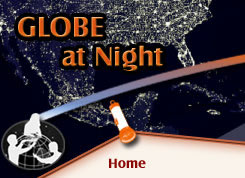 It's that time of year again...time for our annual campaign to measure the levels of light pollution in our night skies. This year's GLOBE at Night campaign runs from March 3rd to the 16th. It is very easy to participate and contribute to our world wide map of light pollution.
It's that time of year again...time for our annual campaign to measure the levels of light pollution in our night skies. This year's GLOBE at Night campaign runs from March 3rd to the 16th. It is very easy to participate and contribute to our world wide map of light pollution.All you have to do is go outside after it gets dark and find the constellation of Orion. Look closely at what you see in the sky and compare it to the magnitude charts. Here is what they look like.

You simply look at the sky and compare it to the charts. Pick the one that looks closest to what you see in the sky and you have your data point. You might notice that magnitude 7 has a lot of stars and magnitude 1 has very few. In astronomy, higher numbers mean dimmer stars (it's a long story).
You will also need to know your latitude and longitude. If you have a GPS system, great (many cell phone GPS systems will tell you your latitude and longitude). If not, no big deal...all you need is your address and you can find your latitude and longitude using sites such as iTouchmap. You can then use the form to report your measurements online. You can then use the mapviewer to see your data and data from around the world.
It's pretty easy. We are looking for lots of data. Last year, there were over 15,000 reports from around the world and we would love to top that this year. You can make more than one observation. You can make them from home, the grocery store, a park, the movie theater, pretty much anywhere you go at night and it just takes a couple of minutes. I try to go for several bike rides during GLOBE at Night. I have a Garmin Forerunner GPS on my wrist and record all my data using the voice recorder on my iPod. I go out several nights and bike a different direction each time, getting a dozen or so measurements each night. I live near the edge of Tucson, so I get very different results if I bike west (into Tucson) versus east (toward Saguaro National Park). That is exactly what we would like. Lots of data in different cities...from the densely populated and brightly lit downtown to the suburbs as they give way to the countryside.
So why should you care? Well, we are losing out night skies. Many people have never seen a truly dark sky or if they have, it is a childhood memory. Light pollution is wasted energy and hence money. Light pollution has many negative effects on wildlife as well.
Still not enough for you? How about your own health? Last summer, the American Medical Association passed resolution 516, "Advocating and Support for Light Pollution Control Efforts and Glare Reduction for Both Public Safety and Energy Savings" identifying light pollution as a human health concern. You can read the entire resolution here. In part it says
"Whereas, Light trespass has been implicated in disruption of the human and animal circadian rhythm, and strongly suspected as an etiology of suppressed melatonin production, depressed immune systems, and increase in cancer rates such as breast cancers 16,17,18,19,20,21,22; and
Whereas, Light trespass disrupts nocturnal animal activity and results in diminished various animal populations’ survival and health 23; therefore be it of energy efficient designs to reduce waste of energy and production of greenhouse gasses that result from this wasted energy use (New HOD Policy); and be it further
RESOLVED, That our AMA support light pollution reduction efforts and glare reduction efforts at both the national and state levels (New HOD Policy); and be it further
RESOLVED, That our AMA support efforts to ensure all future streetlights be of a fully shielded design or similar non-glare design to improve the safety of our roadways for all, but especially vision impaired and older drivers. (New HOD Policy)"
Now of course the solution is not to turn off all lights...that would be silly. Lights are needed at night for safety and security. The solution is well designed lighting the directs light where you need it, when you need it, and in the correct amount. Too much light can cause glare and make it more difficult to see which can be just as dangerous as not enough light.
So come on out and help us get our data and full up that map!






3 comments:
I find it very interesting that research is confirming light pollution has a correlation on human health, especially with reference to breast cancer. The Chicago to Milwaukee corridor show elevated instances of breast cancer in comparison to other areas. If you pull up a map online of light in the night sky, you can easily define that we are in a very high light area.
So many good causes, so little time.
Did it, done... I should have put on a coat. Brrrr!!!!
Post a Comment